
![]()

![]()
| Care of the Cocker Spaniel Coat |
![]()
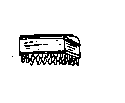 |
Grooming a Cocker Spaniel should be a daily routine. The
coat should be brushed and combed 3 to 4 times per week. Begin with the massage-brush (this is an all rubber brush with flexible bristles). |
||||||||
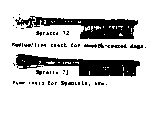 |
After this, the coat should be thoroughly combed. A wide-toothed comb should be used on the long hair on the ears and the body feathering. The next step should be to use a fine-toothed comb (e.g. Spratts 72 or even finer a 73). This should be used on the head, neck and body until all the dead hair is removed. Always brush and comb the hair in the direction in which the hair grows. | ||||||||
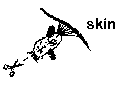 |
The hair behind the ears, in the armpits and in the groin of the Cocker can easily become matted. Should this occur, at first try to split the mat with your fingers or a wide-tooth comb. If this is not successful then carefully cut into the mat using sharp scissors and then brush or comb it out. If the mat is too large then it may be necessary to carefully cut it out and wait for the new hair to grow back. | ||||||||
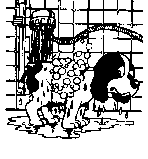 |
From time to time your Cocker Spaniel may need a bath. You should use a good quality shampoo formulated for use on dogs. After the dog has been shampooed, a creamrinse will leave the coat lying beautifully flat. Finally rinse the coat well and take care that no shampoo gets in the eyes or ears of the dog. After rinsing, towel the dog off and keep him in a warm airy room until he is thoroughly dry. Eventually you may want to use a hand held blow dryer on the longer hair. As dogs are very susceptible to chills be sure he is thoroughly dry before permitting him to go outside. | ||||||||
| How to Trim your English Cocker Spaniel | |||||||||
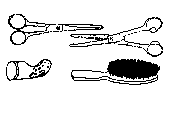 |
Equipment needed:
|
||||||||
 |
Before you begin to trim your dog be sure the coat is well
brushed and combed and totally mat free. |
||||||||
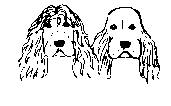
|
Begin with the head. The hair must be short and flat. All long hair on the skull must be plucked using the thumb and forefinger. The long hair around and approximately the top third of the ear must be carefully removed. Always pluck the hair in the direction in which the hair grows. Eventually you can use the rubber finger cones. Never use scissors in this area as the hair will grow back thicker than before and will be more difficult to hand pluck. If you do this regularly your Cocker Spaniel will retain his beautiful head and expression. |
||||||||
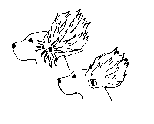 |
When you hold the ear up you will see long hair under and around the ear-canal. This should be trimmed with the thinning scissors (or carefully with the sharp straight-edge scissors). By doing this the ear will lie flat against the head and you avoid the ear-canal becoming too warm and moist which can lead to ear infections. It will also be easier to clean should it become dirty. | ||||||||
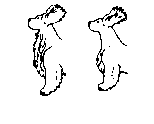 |
The long hair from the throat area to the breastbone should be trimmed using the thinning scissors. The chest hair rarely needs trimming. only if it is too long should the ends be trimmed to give a natural look. | ||||||||
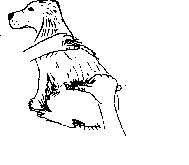 |
The neck, shoulders and ribs should be thoroughly brushed. If the coat is too thick or woolly then you should use a fine comb (e.g. Spratt 72) in combination with your thumb on the comb, to remove the dead and woolly hair. Go through the coat, section by section, with the fine comb. | ||||||||
 |
When you stand above the dog and look down any hair that sticks out from the ribs, should be removed. | ||||||||
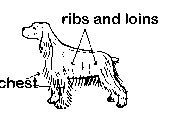 |
The body feathering should not be trimmed unless it has become too long or untidy. | ||||||||
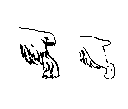 |
The hair on the thighs should lay as flat as possible, using brush, comb and hand plucking method. The feathering on the front of the rear legs should be a little longer than the stifle. The extra hair on the tail should be trimmed using thinning scissors. | ||||||||
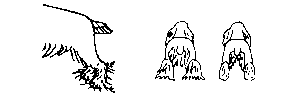 |
The bend on the inside of the rear legs is called the hock. The excess hair on the inside and outside of the hocks should be hand-plucked and finished off with the thinning scissors. The back of the hind leg from hock down should be trimmed with the thinning scissors. The trousers (the long hair between the back legs) should be well combed. If the trouser hair is too long this can be carefully trimmed away. Do not trim higher than the hock. | ||||||||
| The hair on the thighs should blend into the trouser
feathering. The hair under and around the tail and anus should be carefully trimmed away. |
|||||||||
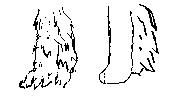 |
Any long hair on the front of the forelegs should be
hand-stripped until it is smooth. The hair on the back of the forelegs, the feathering, should be carefully shaped and shortened only if it is very long and untidy. Take care that the feathering does not touch the ground. This can be avoided by combing the feathering down to the back of the top of the pad and then trimming off any excess hair with the scissors. |
||||||||
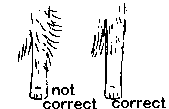 |
Any hair sticking out at the sides of the front leg should be carefully plucked away. | ||||||||
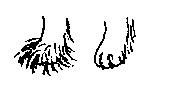 |
The foot of the Cocker Spaniel should be small and tight. All excess hair should be trimmed away using the straight scissors and finished off with the thinning scissors. | ||||||||
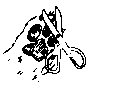 |
The excess hair under the foot should be cut off even with the pad (do not cut the hair between the pads). | ||||||||
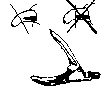 |
Check that the nails are not too long. If they are too
long then they must be carefully clipped. Do not cut them too short or you will cut into
the "quick", this is the living part of the dog's nail. Cut your dogs nails
carefully with specially-made canine clippers, (e.g. the guillotine clippers). The nail of the fifth toe does not touch the ground. Check that these do not grow long and curl round and grow into the flesh. This is extremely painful. The cut nails should then be smoothed over with a nail file. Source: Fingolfin's English Cocker Spaniels |
||||||||
So, is trimming making a big difference to your English Cocker Spaniel? Judge it for yourself:
 |
 |
 |
| dog "A" before | dog "B" before | dog "C" before |
 |
 |
 |
| dog "A" after | dog "B" after | dog "C" after |
I know it is hard to believe, but it's the same dog!
![]()
![]()